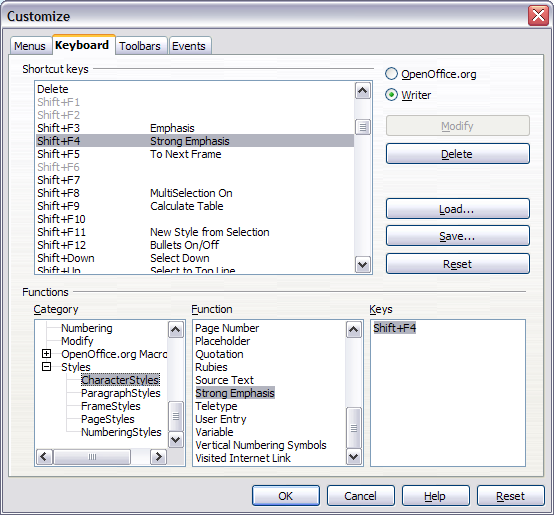Assigning shortcut keys
In addition to using the built-in keyboard shortcuts (listed later in this Appendix), you can define your own. You can assign shortcuts to standard Writer functions or your own macros and save them for use with Writer only, or with the entire OpenOffice.org suite.
Caution: Be careful when reassigning your operating system’s or OOo’s predefined shortcut keys. Many key assignments are universally understood shortcuts, such as F1 for Help, and are always expected to provide certain results. Although you can easily reset the shortcut key assignments to the OOo defaults, changing some common shortcut keys can cause confusion, frustration and possible data loss or corruption, especially if other users share your computer.
To adapt shortcut keys to your needs, use the Customize dialog, as described in this section and in the section titled “Assigning styles to shortcut keys” in Chapter 7 (Working with Styles).
As an example, suppose you wish to apply a particular character style during document creation or editing, for example to add emphasis to a word, and you would like to do this using a shortcut key combination, rather than using the rather more long-winded menu access. You could assign Shift-F3 as a shortcut for this purpose, as described below:
- Select Tools > Customize > Keyboard. The Customize dialog opens.
- To have the shortcut key assignment available only with Writer, select the Writer button (located at the upper right corner of the Keyboard tab); otherwise select the OpenOffice.org button which will make it available to every component.
- Next select Styles > CharacterStyles in the Category list and Strong Emphasis in the Function list.
- Now select the shortcut keys Shift+F4 in the Shortcut keys list and click the Modify button at the upper right.
- Click OK to accept the change. Now the Shift+F4 shortcut will apply the Strong Emphasis style to any selection.
Notes:
- All existing shortcut keys for the currently selected Function are listed in the Keys selection box. Since there is no currently assigned shortcut for the Styles > CharacterStyles function the Keys list is empty. If it were not, and you wished to reassign a shortcut key combination that is already in use, you must first Delete the existing Key.
- Shortcut keys that are greyed-out in the listing on the Customize dialog, such as F1 and F10, are not available for reassignment.
- Remember, since the Writer button was selected at the start of this procedure, the newly assigned shortcut key will only work within the Writer component. To set this shortcut for use by all of the components within the suite, repeat this procedure after first selecting the OpenOffice.org button.
Saving changes to a file
Changes to the shortcut key assignments (and other configurations) can be saved in a keyboard configuration file for use at a later time, thus permitting you to create and apply different configurations as the need arises. To save keyboard shortcuts to a file:
- After making your keyboard shortcut assignments, click the Save button near the bottom right of the Customize dialog.
- In the Save Keyboard Configuration dialog, select All files from the Save as Type list.
- Next enter a name for the keyboard configuration file in the File name box, or select an existing file from the list. If you need to, browse to find a file from another location.
- Click Save. A confirmation dialog will appear if you are about to overwrite an existing file, otherwise there will be no feedback and the file will be saved.
Loading a saved keyboard configuration
To load a saved keyboard configuration file and replace your existing configuration, click the Load button near the bottom right of the Customize dialog, and then select the configuration file from the Load Keyboard Configuration dialog.
Resetting the shortcut keys
To reset all of the keyboard shortcuts to their default values, click the Reset button near the bottom right of the Customize dialog. Use this feature with care as no confirmation dialog will be displayed; the defaults will be set without any further notice or user input.
Running macros
You can also define shortcut key combinations that will run macros. These shortcut keys are strictly user-defined; none are built in. For information on macros, see Chapter 17 (Getting Started with Macros) in the Getting Started book.
| Content on this page is licensed under the Creative Common Attribution 3.0 license (CC-BY). |
